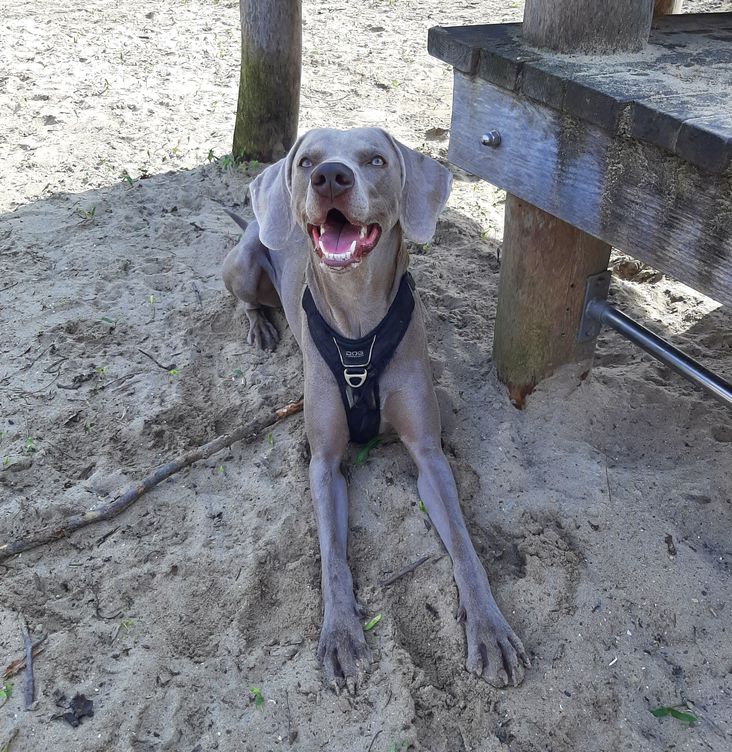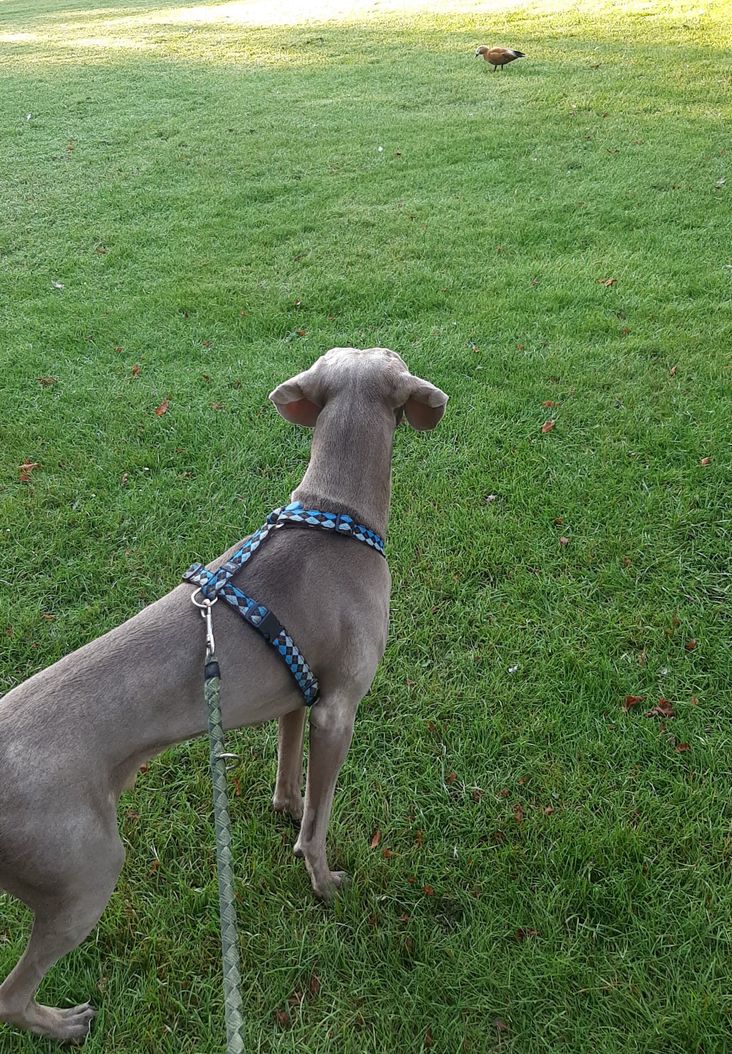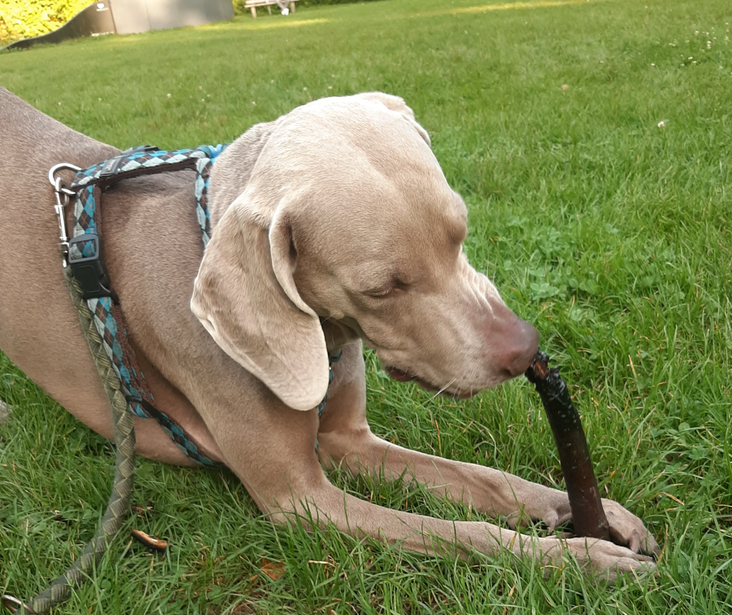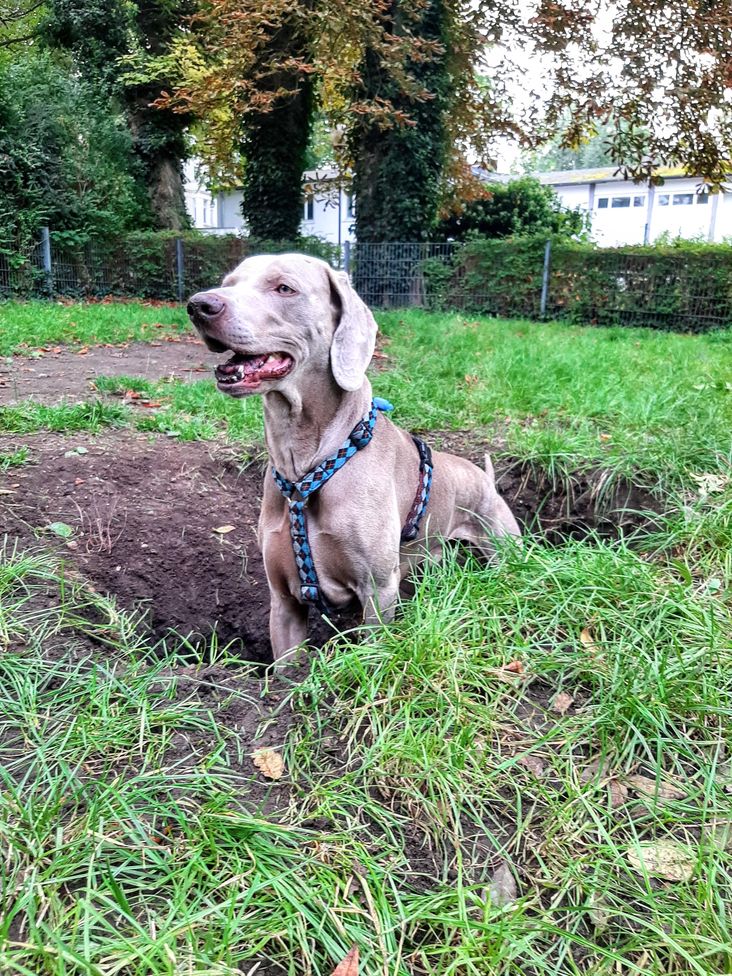Home Office With a Weimaraner: My Experience
Sep 13, 2024 by Vreny Blanco · 6 min read · Remote Work

Meet da Vinci, the most beautiful Weimaraner. He’s a friend’s dog, and I had the opportunity to take care of him for a few days. During that time, I had to learn a few tricks to give him the exercise and attention he needed, and figure out how to adjust my work and exercise routine.
In this blog post, I will describe my experience babysitting a Weimaraner while working from home.
Key Traits of Weimaraners
Size and Build
- Large and athletic breed
- Weight: 25 to 40 kilograms (55 to 88 pounds)
- Height: 58 to 69 centimeters (23 to 27 inches)
Appearance
- Sleek, silver-gray coat
- Striking blue or amber eyes
Energy Levels
- Highly energetic and active
- Require at least two hours of vigorous exercise daily
Exercise Needs
- Ideal activities include running, hiking, and playing fetch
- Without sufficient exercise, they can become bored and develop behavioral issues
Mental Stimulation
- Weimaraners are highly intelligent hunting dogs
- They thrive on mental challenges
- Weimaraners enjoy puzzle toys, obedience training, and interactive games
Companionship
- Excellent companions for active individuals or families
- Require a balanced routine of physical and mental activities

My Experience
I have always loved dogs and had three of my own as a child (a German Shepherd, a mixed breed, and a Golden Retriever). So, the moment I met da Vinci, I fell in love with him.
Da Vinci is 2 years old, full of energy, incredibly smart, and very sweet. I have known him for a little over a year, and it took me several walks with him to gain his trust. Weimaraners can be indifferent to strangers, so don’t expect one to greet you warmly at the first meeting, unlike some other breeds, such as Golden Retrievers.
Weimaraners are very loyal and form close bonds with their owners, so after my friend left him at my house, da Vinci started to look for him everywhere in the apartment and began to bark. To calm him down, we went for a walk and played in a nearby park.
Routine
At home with his owner, da Vinci has his daily routine, which I tried to maintain as much as possible. If I was working and couldn’t go for a walk at the usual time, he would remind me by pacing back and forth from the door to my chair.
I have a specific daily work and exercise routine that I had to modify during this time. Normally, I walk at least 15,000 steps a day on my treadmill desk. This was easy to achieve with da Vinci, as he needs several walks a day. Here’s how my schedule looked:
- 08:00 – Walk in the park
- Breakfast, Work
- 11:30 – Walk in the park
- Lunch, Work
- 16:00 – Walk in the park
- Work, Dinner
- 20:00 – Walk in the park
- 22:00 – Short walk before bed
Feeding
Most adult Weimaraners do well on two meals a day, ideally fed in the morning and evening.
Feeding schedules should be carefully planned. Weimaraners have sensitive stomachs, so their diet must be carefully managed to avoid digestive issues. To reduce the risk of bloat or gastric dilatation volvulus (GDV) — a sudden and life-threatening condition — they should not be fed immediately before or after exercise.
Wait at least 30 minutes to an hour after a meal before going for a walk, and two hours if you plan to participate in strenuous activity with your dog.

Weimaraners and Other Animals
As hunting dogs, Weimaraners have a strong instinct to chase. They are among the fastest dog breeds, capable of reaching speeds of up to 56 km/h (35 miles per hour).
If you’re walking in a park with freely roaming animals like ducks or pigeons, keep your dog on a leash and let them run free only in designated dog areas.
Weimaraners may also chase bikers, joggers, or anything that moves—an instinct that can only be managed, not trained out.
During his time with me, da Vinci did not approach other dogs. He found the ducks and other birds in the park very interesting, so I had to be careful and hold the leash firmly.

Chewing on Things
Weimaraners love to chew. Da Vinci enjoys playing with and chewing on sticks, which makes outdoor playtime fun. At home, there are appropriate toys or snacks you can give your dog to keep him occupied and entertained, and to prevent him from destroying household items.

Grooming
The Weimaraner has a beautiful, soft, short, and flat coat that requires minimal grooming. Although they shed moderately, brushing with a rubber curry comb once a week helps reduce shedding and keeps their coat shiny.
The only “problem” I had was that we discovered a dog park where da Vinci could dig holes, and he loved it! So afterwards, he would be totally covered in mud. But nothing a brush and a bath couldn’t fix. We also have a robot vacuum that ran daily to keep the apartment clean.

Weimaraners Do Not Like to Be Alone
Weimaraners don’t like to be alone and can develop separation anxiety, which can lead to excessive barking or chewing on anything they can find.
Da Vinci had been trained by his owner to be left alone at home, but he had never been to my place before, so we had to retrain him and help him adjust to this new environment.
Although my apartment is not very big, da Vinci followed us everywhere (even to the bathroom). We had to retrain him to understand that even if we were in another room with the door closed, we would eventually come out and everything would be fine. It took some barking and crying, but eventually he got it.
Weimaraners Can Be Loud
During this time, there were street repairs in front of my apartment, which sometimes made da Vinci nervous due to the noise. He would bark at the machines and workers.
We set up Alexa to detect da Vinci’s barking and crying and automatically tell him to calm down while playing “dog relaxation music” (there’s a playlist on Spotify). After a few tries, da Vinci calmed down and fell asleep.

Conclusion
Weimaraners are not a breed for everyone. They are large, powerful, intelligent dogs that thrive on discipline and routine. They need a lot of physical and mental stimulation, and their high energy levels can be difficult to manage. If you are considering adopting a Weimaraner, be prepared to invest time and effort in their training.
With the right regimen and a few tricks, it is possible to create a harmonious environment for both you and your Weimaraner. If you are an active person who enjoys regular walks and are looking for a loyal and intelligent companion, a Weimaraner may be the perfect choice for you. With dedication and proper care, the bond you form with your Weimaraner can be incredibly rewarding.

Further Reading
You may also like: Cognitive Benefits of Walking Your Dog.



